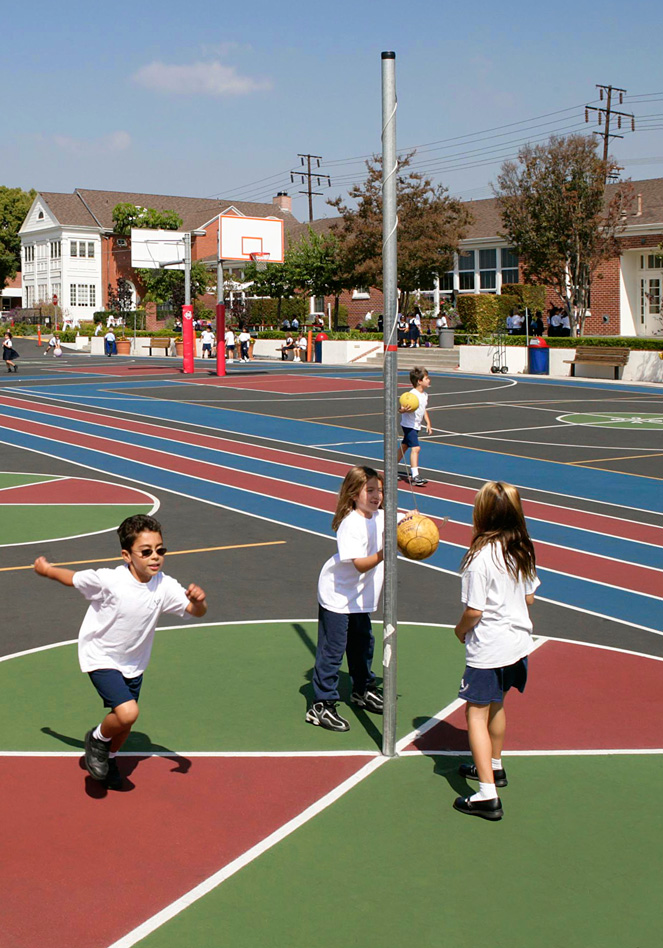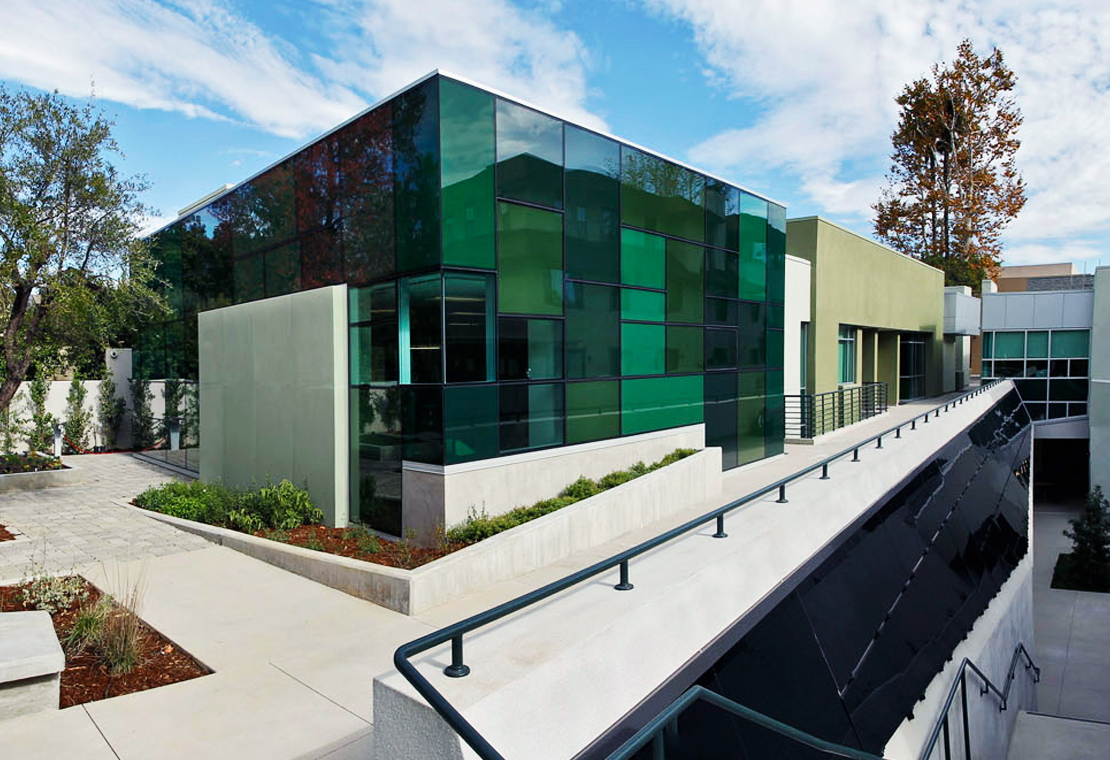EducationARCHITECT
EducationARCHITECT
ADDRESSING THE DESIGN NEEDS OF TODAY’S INDEPENDENT SCHOOLS
Summer 2012 – Volume 12 Number 4
Community Relations
Community Relations
In Search of Harmony
For the afternoon pick-up, Notre Dame Academy Elementary playground (Below) converts to a double row queue stack accommodating more than 30 vehicles on-site.

From conception to realization a school expansion project can be long and complicated. As one might expect, the process includes assessing needs and wants, plan development, fundraising and ultimately a period of construction. For anyone that has added to their house or remodeled their kitchen, you know of the need for perseverance and a good sense of humor. But in the world of K-12 schools there is an additional step in the process – one that not only adds time but can affect our natural penchant to smile through the adversity.
Obtaining the Coveted C.U.P.
To build new or expand existing facilities, schools typically need to obtain an “entitlement” approval under the local zoning laws. In most jurisdictions there are many zones that do not allow a school use as a matter of right. The institution can apply to operate in these zones but must agree to restrictions. Entitlement is achieved by obtaining a conditional use permit, oftentimes referred to by the acronym C.U.P.
The process involves a public hearing; the announcement of which can be a lighting rod that galvanizes neighborhood opposition. If the neighbors were not previously organized a C.U.P application can certainly cause that to change. And, if led by de-tractors, the entitlement process will be a long and expensive slog indeed.
Although there are a variety of reasons why people object to schools, it mostly boils down to the issues of traffic and parking. Schools typically enroll students from a large geographic area. Busing is often not a logistical or economically viable option. This leads to an early morning and late afternoon convergence of parents, grandparents and day-care providers. The queue lines slow local traffic and a dearth of street parking causes blocked driveways and heated tempers.
At the public hearing irate residents arrive in force. Each takes a turn at the microphone, usually expressing resentment for the impositions on their tranquility and their city streets. From the neighbors’ viewpoint, the students are “other people’s children.” That is the crux of the problem. In order to be accepted into the community the school needs to be viewed as a part of the community.
Neighbors Want To Feel They Are Being Heard
Neighbors Want To Feel They Are Being Heard
So how does a school with a large geographic draw become an integral member of the immediate surrounding neighborhood? There are some measures that can be taken to reduce impacts and create a closer bond with the nearby residents. It is most important that the groundwork of good relations occur long before any application for expansion is contemplated.
The necessity of appointing a Community Relations representative should not be underestimated. As a contributing member of the local community it is imperative that the school be represented at all neighborhood events.
If the neighborhood is not organized the school should actively help them do so. It is more productive to interface with leaders elected in calm times than with those drafted (or self-selected) to lead the charge into the breach.
If the community is in need of a meeting place, schools have the perfect facilities. Classrooms, multi-purpose rooms and libraries provide comfortable surroundings for after-school gatherings. Schools also have workrooms and equipment that could be made available for the printing of newsletters and flyers. This provides the benefit that the institution will be perceived as the neighborhood “home base.”
Separately, the school head should regularly meet with the neighborhood to discuss mutual interests and field complaints. Like anyone, neighbors want to feel that they have been “heard” by the leadership. Providing the direct phone number and email address of the school’s Community Relations representative assists in heading off issues which may occur between gatherings.
Schools should regularly distribute their calendar. It is important to diligently inform the community as to the dates and times related to games, special events,
So how does a school with a large geographic draw become an integral member of the immediate surrounding neighborhood? There are some measures that can be taken to reduce impacts and create a closer bond with the nearby residents. It is most important that the groundwork of good relations occur long before any application for expansion is contemplated.
The necessity of appointing a Community Relations representative should not be underestimated. As a contributing member of the local community it is imperative that the school be represented at all neighborhood events.
If the neighborhood is not organized the school should actively help them do so. It is more productive to interface with leaders elected in calm times than with those drafted (or self-selected) to lead the charge into the breach.
If the community is in need of a meeting place, schools have the perfect facilities. Classrooms, multi-purpose rooms and libraries provide comfortable surroundings for after-school gatherings. Schools also have workrooms and equipment that could be made available for the printing of newsletters and flyers. This provides the benefit that the institution will be perceived as the neighborhood “home base.”
Separately, the school head should regularly meet with the neighborhood to discuss mutual interests and field complaints. Like anyone, neighbors want to feel that they have been “heard” by the leadership. Providing the direct phone number and email address of the school’s Community Relations representative assists in heading off issues which may occur between gatherings.
Schools should regularly distribute their calendar. It is important to diligently inform the community as to the dates and times related to games, special events, performances and other gatherings that may have impacts. And providing complementary tickets is often appreciated.
performances and other gatherings that may have impacts. And providing complementary tickets is often appreciated.
Furnishing use of the sports facilities for local groups, or sponsoring Boy and Girl Scouts, are other ways to involve the community. The school’s pride becomes the community’s pride. Academic and athletic achievements become achievements that can be celebrated by the whole community. Your children are their children.
Issues related to transportation do not have universal solutions, though there are many common threads. Carpooling should be a requirement. No vehicle should be delivering or picking-up only one child. While an earlier start caused by the morning carpool may be a drawback, the parents do obtain the benefit of dividing the driving responsibilities.
Schools should discourage the queuing on city streets. This is one of the leading complaints by neighbors. The afternoon convergence can easily overwhelm the available queue space on the school grounds and extend into the immediate neighborhood. And it is not uncommon for many of these vehicles to arrive long before the final bell. These idling cars spew pollutants, slow traffic and block driveways. Careful consideration should be given to either expanding the on-site queuing capability or staggering the dis-missal to lessen the impact.
Schools need to see their institution through the eyes of their neighbors. In doing so, the staff, parents and students will become aware of the issues and their impact on the surrounding community. To be a good neighbor is to be the member of the community that serves the best interests of all. With hard work, planning and communication an independent institution can be seen as a valuable and desirable resource that engenders neighborhood pride.
Furnishing use of the sports facilities for local groups, or sponsoring Boy and Girl Scouts, are other ways to involve the community. The school’s pride becomes the community’s pride. Academic and athletic achievements become achievements that can be celebrated by the whole community. Your children are their children.
Issues related to transportation do not have universal solutions, though there are many common threads. Carpooling should be a requirement. No vehicle should be delivering or picking-up only one child. While an earlier start caused by the morning carpool may be a drawback, the parents do obtain the benefit of dividing the driving responsibilities.
Schools should discourage the queuing on city streets. This is one of the leading complaints by neighbors. The afternoon convergence can easily overwhelm the available queue space on the school grounds and extend into the immediate neighborhood. And it is not uncommon for many of these vehicles to arrive long before the final bell. These idling cars spew pollutants, slow traffic and block driveways. Careful consideration should be given to either expanding the on-site queuing capability or staggering the dis-missal to lessen the impact.
Schools need to see their institution through the eyes of their neighbors. In doing so, the staff, parents and students will become aware of the issues and their impact on the surrounding community. To be a good neighbor is to be the member of the community that serves the best interests of all. With hard work, planning and communication an independent institution can be seen as a valuable and desirable resource that engenders neighborhood pride.

(Above) The first floor of the LEED Platinum certifed Westridge School Sustainable Science Building was placed below grade so as to maintain the neighbors view to the distant mountains. The lower level opens to a courtyard providing daylighting and natural ventilation in every room. The award winning project was designed by Pica + Sullivan Architects, Ltd. Photograph by Randall Michelson Photography.
Pica + Sullivan Architects, Ltd. specializes in master planning, architectural design and project management for non-profit schools, religious institutions, and social service organizations. Our approach includes hands-on principals who are involved in the project from inception through completion; flexible and responsive staff who have a long history with the firm; a value-engineering approach to design where the cost-benefit is considered throughout; contextual approach to design where an architecture unique to the context is developed for each client; understanding of the non-profit client as a multi-faceted group of constituents; and most importantly multiple projects with most clients which demonstrates the level of confidence and trust that is placed in Pica + Sullivan Architects.
